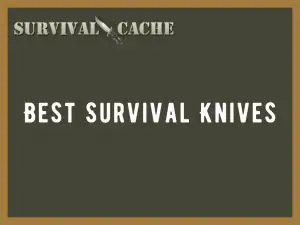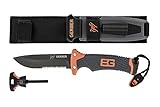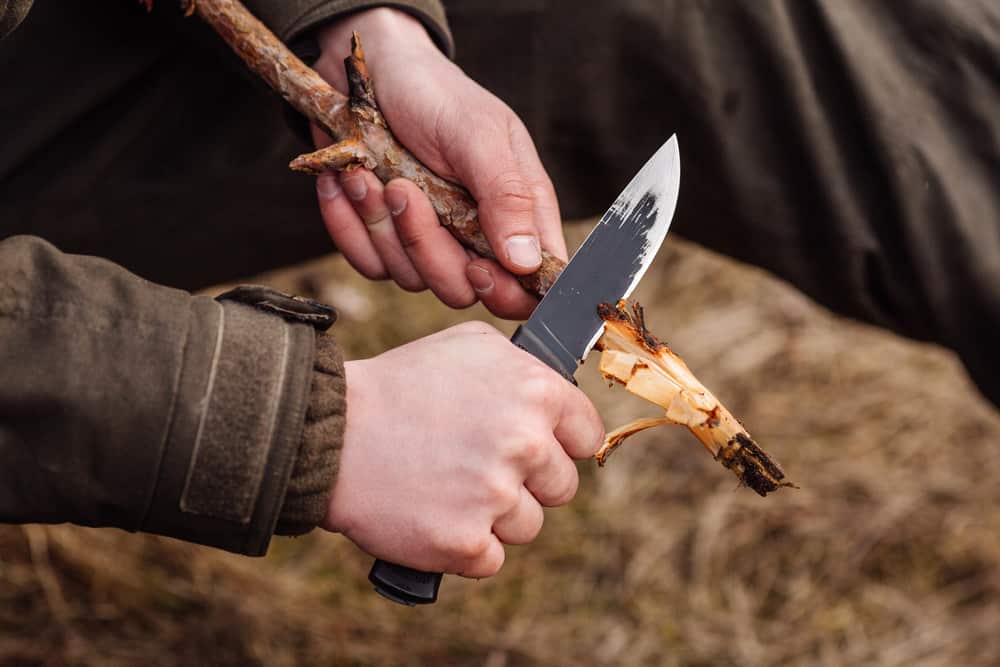A Survival Knife is probably the single most important tool in your survival gear. You can do a LOT to survive in the wilderness with nothing but a good knife.

In fact, it’s an essential EDC tool that will be useful in so many ways. You can use it as a rescue tool, clean out any fresh game kills, or if the situation warrants it a self-defense situation. You can never go wrong with a survival knife that is reliable, durable, and easy to carry. Finding one can be a daunting task. But if you have a good idea of what you are looking for in a knife, the selection process won’t be so difficult.
At a quick glance, here are our top survival knife picks if you are in a hurry:
| KNIVES | DETAILS | ||
|---|---|---|---|

#1 Survival Knife
|
|
Check Price on Amazon.com
|
|

|
|
Check Price on Amazon.com
|
|

|
|
Check Price on Amazon.com
|
|

|
|
Check Price on Amazon.com
|
|

|
|
Check Price on Amazon.com
|
That said, here are the top things you should consider when choosing a survival knife.
SKIP AHEAD
How To Choose a Survival Knife: Buying Guide
Here are the top things you should take into considerations. We surveyed our team to put together this list:
1. Tang
The Tang of a knife is the portion of the blade that extends down into the handle. The Tang and the blade are one solid piece of steel. A Full Tang, or tang that goes all the way to the base of the handle, is considered the best for a quality survival knife. The full tang gives the entire knife strength. On cheaper knives the blade is only connected to the top of the handle and can break off.
2. Handle
The handle on survival knives varies widely. Some are hard rubber, others polymer. Many are good and it is probably easiest to remember what you should avoid; Any knife that has a hollow handle for “storing things.” While this sounds neat at first there are a couple of good reasons to avoid knives like this.

- If it has a hollow handle the knife certainly doesn’t have a full tang, which we mentioned earlier was important.
- If you are storing matches in your knife handle, and you lose the knife guess what else is gone…?
Another thing to avoid that is popular among novelty survival knives is a compass in the handle. Again, seems like a cool feature, but it could mess up your grip on the knife. Is it really worth having a 25 cent compass in the handle of one of your most important tools when there is a chance it will make the knife hard to work with or even injure you? In a survival situation that is unacceptable.
3. Blade Metal
Survival Knives generally come in two types of steel: Stainless or Carbon. Which is better is a huge debate and I won’t recommend which one you should choose but here are the main differences.
- Stainless Steel is…well it’s stainless steel. Virtually indestructible, can take a beating and last a long time without rusting. However many people say stainless blades lose an edge faster than carbon.
- Carbon Steel knives are usually known to hold a good edge longer than stainless steel, but will rust faster in the elements.
4. Blade Design
Again this one comes down to a debate over which is better; straight blade or serrated. A straight blade knife will work better for chopping wood and is much easier to sharpen. A good smooth stone can even be used to sharpen a straight blade if you are without a whetstone, whereas a serrated edge almost always takes a special sharpener.
5. Blade Length
Most Survival Knives fall within the range of 6 to 12 inches. Any less and it might not be big enough to do the things you will have to get done in a survival situation, like chopping wood. Sure, it would work a lot better with a hatchet or saw, but if you Bug Out, you might not have anything else.
However, start getting much bigger than 9 to 10 inches and you start getting Rambo syndrome. This is the point where the knife is getting too big to handle and carry effectively and might be more of a hindrance than a tool.
6. Blade Thickness
This is a harder one for those of us who are not knife experts. A good general rule is about 3/16 -4/16 of an inch thickness is the best for survival knives. A knife of that thickness will be extremely solid and able to withstand the abuse of wood chopping and prying. You do not want a survival knife that has a lot of flex in the blade.
7. Sheath
If you aren’t familiar with serious survival knives the sheath of your knife can seem less than important, however, the sheath will affect a lot about how you carry and draw your knife. There are really three things you want in your ideal sheath:
- Lower Attachment – Some type of hole or attachment piece at the tip end of the sheath used for strapping the knife to your leg when on the belt, or onto a backpack strap.
- Belt and Lanyard Attachment: Does the sheath come with a belt loop? Does the knife handle itself have a hole for a lanyard?
- Strap: How does the sheath close around the knife? A crossover strap right where the handle meets the sheath is best. Sheaths with the strap at the base of the handle can allow the knife to slide out.
Keep these things in mind when you buy your next survival knife. Next, we review the best survival knives in the market that our team at SurvivalCache highly recommends.
Best Survival Knives: Our Top Picks
We’ll be taking a look at the following survival knives that are the best in the market. It is important for you to choose one that will fit your personal needs, preferences, and budget. Let’s start with the first option:
Best Overall Survival Knife: Benchmade Bushcrafter Review

The Benchmade is a U.S. company using only the highest quality materials. If you want a knife that is durable, made with the best steel, corrosion-free, and can be carried around daily as EDC, or used in bushcrafting, then this is the knife for you.
The knife is sharp enough to cut wood, animals during cleaning after a hunting session, and to cut bushes. It’s easy to use, and lightweight. We highly recommend this and many of our team members have one of these.
We did a detailed hands-on review on the Benchmade Bushcrafter here as well.
- BUILT FOR THE TRAIL: Robust, rugged style meets unmatched function, no matter the application; A...
- AMERICAN MADE CPM-S30V STEEL: For first-rate edge retention and corrosion resistance; Precision...
Last update on 2024-04-25 at 13:43 / Affiliate links / Images from Amazon Product Advertising API
Best Budget Survival Knife: Smith & Wesson Extreme Ops SWA 24.7 Review

You’re probably thinking that it’s unusual that Smith & Wesson can make knives. That’s normal. While they are one of the leaders in manufacturing concealed carry pistols, they do a heck of a good job manufacturing knives that are sharp, reliable, and all-around useful. The blade is measured at 3.1 inches and is made from high-quality black oxide carbon steel. It’s tough, sharp, and can cut through materials like nothing else. The blade is a hybrid straight blade with a serrated edge on the other half of the knife itself.
This comes with ambidextrous thumb knobs making it a really easy to deploy knife for when you need it most. Whether you are left-handed or right-handed, this knife will definitely have its uses. If you are looking for a great EDC knife that is tactical tough and proven to last you a long time, this might be a great choice for you.
Pros
- Affordable for most budget
- Super tough. Can handle all kinds of abuse
- Easy to deploy
- Perfect for EDC use
- Sharp right out of the box
Cons
- May be difficult to close
- Might be too small for some users
- DIMENSIONS: 7.1 Inch (18 Cm) Overall Length With A Blade Length Of 3.1 Inches (7.9 Cm) And A Weight...
- DURABLE: Blade Is Made Of Reliable 7Cr17Mov Black Oxide High Carbon Stainless Steel With A Black,...
Last update on 2024-04-26 at 09:53 / Affiliate links / Images from Amazon Product Advertising API
Honorable Mentions
We, at SurvivalCache, have reviewed hundreds of knives for various purposes. While we do recommend the Benchmade Bushcrafter as the best, these knives below are all close second.
- Bear Grylls Ultimate Knife: one of the more affordable all-rounded knives made out of carbon stainless steel. Recommended.
- Morakniv Bushcraft: made our of carbon steel, built-in fire starter, and sheath for diamond sharpening
- Fallkniven A1 Pro: most expensive out of the bunch. However, Fallkniven makes quality knives that are not for daily use but can be used as a weapon for survival situations
- Benchmade Adamas: folding knife made by Benchmade. Very versatile knife for day-to-day EDC.
Survival Knife Hands-On Reviews
Our team has done the following hands-on reviews of survival knives below.
Fallkniven Knives
See reviews of the Fallkniven
- A1
- A2
- MB Modern Bowie
- S1 Pro
- and the Jarl
Morakniv Knives
See reviews of the Morakniv Bushcraft. If you are looking for a comparison, we did a hands-on of the Morakniv Bushcraft vs Companion.
Benchmade Knives
See reviews of the
Kabar Knives
We put together a detailed guide on Kabar knives and which are the best. For specific reviews, check out the following:
Other Knives Reviewed
- Parry Blade
- Gerber Bear Grylls Ultimate Knife
- CRKT Redemption Knife
- Spyderco Sage 2
- Emerson Karambit Fixed Blade Knife
- Cold Steel SRK
- Ontario TAK1
- Schrade SCHF36 and the SCHF37
- Schrade SCHF9
- Kershaw Cryo
Knife Types
Read our guide on choosing a survival folding knife, or EDC knives, or bushcraft knives.
FAQs about Survival Knives
Want to know more about survival knives? These are commonly asked questions among potential buyers that you can use as a guide while searching for your own knife. Consider the following questions:
What is a survival knife used for?
Survival knives can be useful in so many purposes. Among them is self-defense, skinning, whittling, cutting, carving, trapping, among many other situations.
How thick should a survival knife be?
Thickness is one of the major aspects of a survival knife. That’s because it can determine how much abuse it can withstand. Any blades ranging from 3/16 to ¼ of an inch of thickness is ideal for any survival knife.
What is jimping?
Jimping is associated with the knife’s blade. You’ll notice serrated edges on most survival knives that are grooved (or known as jimping). This will allow a better grip and precise cutting each time you use it.
Why do some survival knives have holes?
If your survival knife has holes, then it is designed to reduce friction between the blade and what you’re cutting.
What is the best type of steel for a knife’s blade?
Carbon steel is proven to be one of the most durable types of steel for survival blades. Not only that, but carbon steel is also more resistant to rust, corrosion, and abuse.
How can I sharpen my knife?
For details on that, read our guide on survival knife sharpeners.
Wrap Up
While there are plenty of survival knives out there, it’s hard to choose between one or the other. But if we had to choose the best survival knife, our choice would be the Benchmade Bushcrater and then the Bear Grylls. We point to the obvious features like the sharpness and ease of deployment that are top-notch in these knifes.
A great survival knife is important, no matter how you use it. Why settle for anything less than the best?


